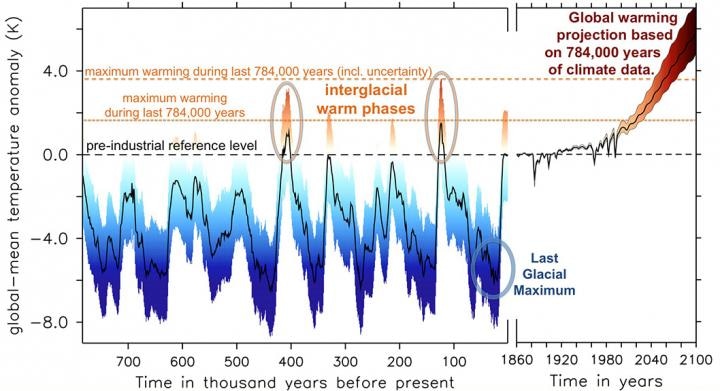Nov 10 2016
 Global mean temperature anomaly with respect to preindustrial reference level. Left panel: Reconstruction of last 784,000 yrs. Right panel: Global warming projection to 2100 based on newly calculated paleoclimate sensitivity. (Credit: Friedrich, et al. (2016))
Global mean temperature anomaly with respect to preindustrial reference level. Left panel: Reconstruction of last 784,000 yrs. Right panel: Global warming projection to 2100 based on newly calculated paleoclimate sensitivity. (Credit: Friedrich, et al. (2016))
The scientific community is very much aware of the well-established fact that an increase in atmospheric CO2 levels leads to global warming. However, with respect to the average global temperature, the effect of global warming may differ.
The findings of a study by Tobias Friedrich of the International Pacific Research Center (IPRC) at the University of Hawaii at Manoa (UHM), which were recently published in the Science Advances journal, propose that when compared to cold climates, warm climates are highly sensitive to CO2 level changes.
Earth’s heat budget loses its balance when the atmospheric CO2 concentrations increase: global surface warming occurs when the retained heat is higher than the expelled heat. The magnitude of warming that is anticipated to occur as a result of increase in CO2 concentration is known as climate sensitivity. Despite the decades of development, this figure, which is conventionally calculated with complex climate system computer models, is still subject to uncertainty.
The recent study involved researchers from the University of Washington, the University at Albany, and the Potsdam Institute for Climate Impact Research, who calculated climate sensitivity with a different outlook - they used the data from Earth’s history. In order to establish the way in which the climate system responded to earlier changes in energy balance, they investigated numerous past CO2 levels and temperature reconstructions.
The first step was to reconstruct the history of global mean temperatures for the last 784,000 years, using combined data from marine sediment cores, ice cores, and computer simulations covering the last eight glacial cycles.
Tobias Friedrich, Post-Doctoral Researcher, IPRC
Calculation of Earth’s energy balance for the aforementioned time period was the second step of the research. This was done by employing greenhouse gas concentration estimates extracted from air bubbles in ice cores, as well as taking into account Milankovitch Cycles, which are astronomical factors having an impact on the planetary heat budget.
"Our results imply that the Earth's sensitivity to variations in atmospheric CO2 increases as the climate warms," explained Friedrich. "Currently, our planet is in a warm phase -- an interglacial period -- and the associated increased climate sensitivity needs to be taken into account for future projections of warming induced by human activities."
The researchers employed these estimates based on Earth’s paleoclimate sensitivity and calculated the warming for the next 85 years that may be caused due to human-induced, business-as-usual greenhouse gas discharge. According to the researchers, global temperatures will increase by 5.9°C (~10.5°F) above pre-industrial values by 2100. This figure matches the upper range of estimates proposed by the Intergovernmental Panel on Climate Change (IPCC).
Our study also allows us to put our 21st century temperatures into the context of Earth's history. Paleoclimate data can actually teach us a lot about our future.
Axel Timmermann, Professor, UHM
The findings of the research show that unchecked human-induced greenhouse gas emissions will presumably alter Earth’s climate far beyond the temperature conditions that have prevailed in the past 784,000 years.
Friedrich concluded saying, “The only way out is to reduce greenhouse gas emissions as soon as possible.”